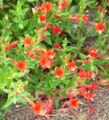Zauschneria
| subsp. var. | ||||||||||||||||||||||||||||||||||||||||||||||||||||||||
|---|---|---|---|---|---|---|---|---|---|---|---|---|---|---|---|---|---|---|---|---|---|---|---|---|---|---|---|---|---|---|---|---|---|---|---|---|---|---|---|---|---|---|---|---|---|---|---|---|---|---|---|---|---|---|---|---|

|
|
| ||||||||||||||||||||||||||||||||||||||||||||||||||||||
| ||||||||||||||||||||||||||||||||||||||||||||||||||||||||
| Standard Cyclopedia of Horticulture |
|---|
|
Zauschneria (named for a professor of natural history at Prague). Onagraceae. Low perennials, some of them subshrubby, few of them used in the flower-garden. Leaves, the lowest opposite, others alternate: fls. racemose, large, scarlet, fuchsia-like; calyx-tube globose, inflated just above the ovary, then becoming funnel-form, 4-lobed, bearing 8 small scales within; petals 4, obcordate, or deeply cleft; stamens 8: caps. slender-fusiform, obtusely 4-angled, 4-valved, many-seeded.— About 7 species, W. N. Amer.
|
- Familia
- Onagraceae
- Species
- Epilobium canum (Greene) P.H.Raven
Cultivation
Propagation
Pests and diseases
Species
Gallery
-
1: E. canum
Note: the variety angustifolium is no longer recognised as distinct from the type E. canum.
References
- Standard Cyclopedia of Horticulture, by L. H. Bailey, MacMillan Co., 1963
External links
- w:Zauschneria. Some of the material on this page may be from Wikipedia, under the Creative Commons license.
- Zauschneria QR Code (Size 50, 100, 200, 500)







